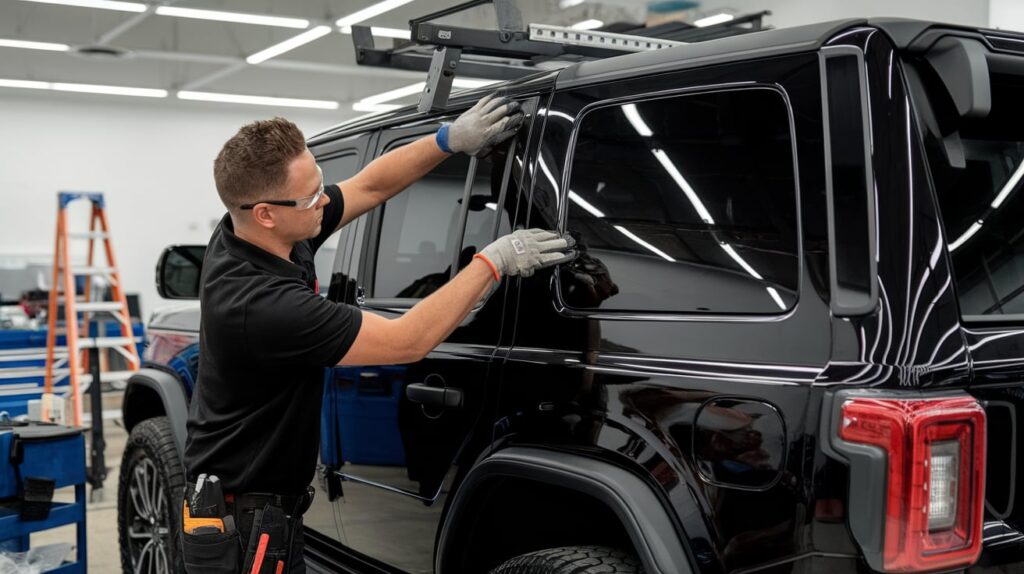Why Slip Solutions Matter for Ceramic Tint Films? Ceramic tint film is not forgiving. One wrong slip mix and you are dealing with streaks, bubbles, or adhesive failure. In Dubai’s heat, that happens faster than you think.
Tinting Slip Solutions are not just about making the film glide. They control tack timing, protect the adhesive, and help ceramic tint settle clean. But ceramic films react differently from dyed or metallic ones. The wrong surfactant or ratio? It ruins the install.
“Most failures come from the slip, not the film.” This is not theory. It is what happens in real workshops, under real heat. If you are using ceramic tint, your slip solution needs to match its chemistry, or you are gambling with the outcome. Tinting Slip Solutions are the difference between a flawless bond and a costly redo.
That’s why choosing the right ceramic tinting service isn’t just about the film, it’s about the process. The best installers use slip solutions formulated specifically for ceramic films, ensuring smooth application without compromising adhesion.
If you’re exploring the best tinting methods for Dubai’s weather, make sure your installer knows the science behind ceramic film and uses products designed for it.
Understanding Ceramic Tint Film Properties
Ceramic tint film is not your average window film. It is engineered with nano-ceramic particles that block infrared radiation without using metal. That means no signal interference, no fading, and serious heat rejection, exactly what Dubai’s brutal sun demands.
But here is the trade-off. Ceramic films are thicker, more adhesive-sensitive, and far less forgiving during installation. You get one shot to lay it right. The adhesive layer responds aggressively to heat, humidity, and, most critically, the slip solution.
“Ceramic tint is like a luxury car. It performs beautifully, but only if handled with precision.”
Unlike dyed or metallic tints, ceramic film needs a slip mix that delays tack just enough to allow repositioning, without compromising adhesion. Too much surfactant? You get streaks. Too little? The film grabs too early and creases.
Tinting Slip Solutions designed for ceramic film must balance glide with grip. That is not easy. It takes understanding the film’s chemistry, the adhesive’s behavior, and how Dubai’s climate accelerates everything. Tinting Slip Solutions are not optional here. They are the difference between a clean install and a film that fails before the customer even drives off.
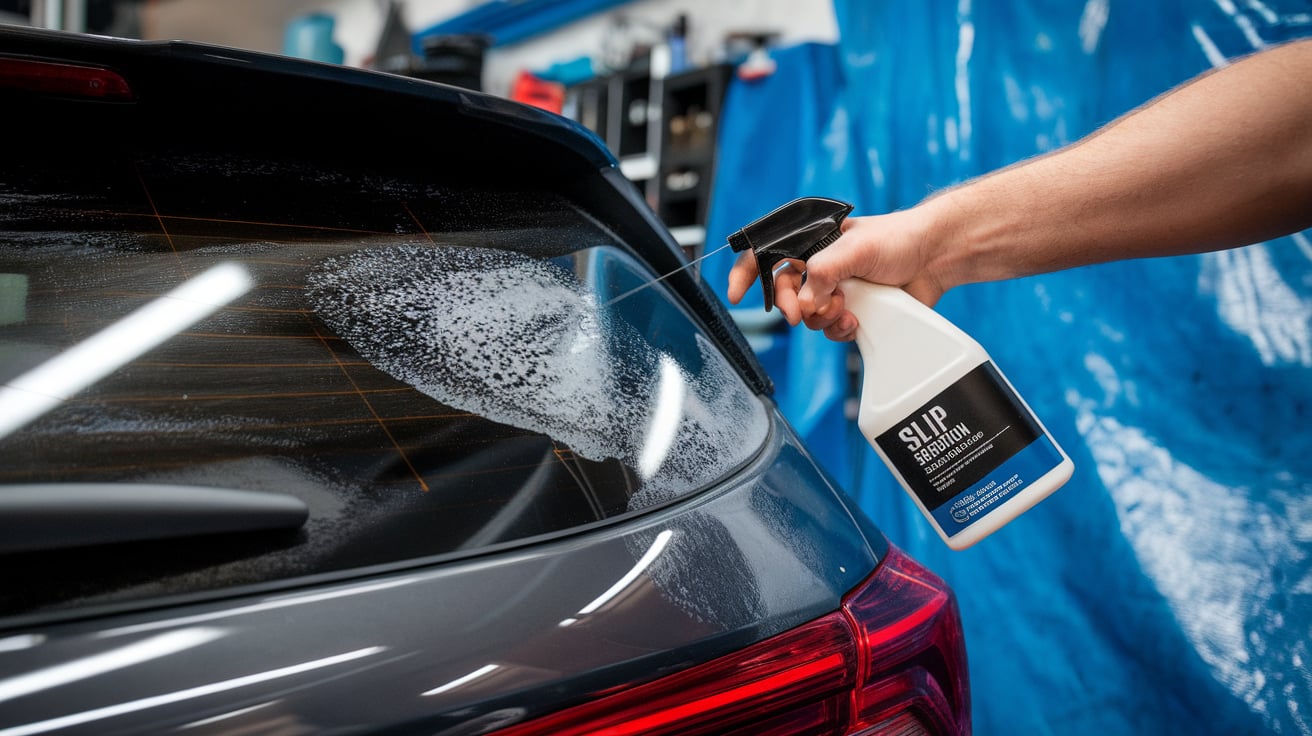
What Makes a Slip Solution Compatible with Ceramic Film?
There is no universal slip mix. Especially not when you are working with ceramic tint film. What glides beautifully on dyed film might cause streaks, premature tack, or adhesive haze on ceramic. And once that happens, there is no fixing it. You strip and start over. Tinting Slip Solutions for ceramic film need to do three things well:
- Delay the tack just enough for clean positioning
- Prevent streaking or residue under the film
- Maintain pH levels that do not disrupt adhesive bonding
Most installers lean on soap-based or shampoo-based mixes. But not all soaps are created equal. Some contain moisturizers, dyes, or additives that interfere with adhesion. Others are too alkaline, throwing off the pH balance and causing haze.
“The wrong slip mix will not show up immediately. It shows up when the film starts lifting two days later.”
Film-safe lubricants like SlipX or Tint-Tac are engineered for this balance. But even then, dilution matters. A few drops too many, and you lose tack control. Too few, and the film grabs you before you are ready.
Tinting Slip Solutions compatible with ceramic film are not just about glide; they are about chemistry. Surfactant balance, pH level, and dilution ratio all play a role. And in Dubai’s heat, where everything dries faster, that margin for error shrinks even more. Tinting Slip Solutions are not a side detail. They are the foundation of a successful ceramic install.
Types of Tinting Slip Solutions Used by Professionals
Ask ten installers what they use, and you will get ten different answers. Some swear by baby shampoo. Others mix Joy dish soap like it is a science experiment. A few go straight for pro-grade formulas like SlipX or Fusion. But here is the thing, Tinting Slip Solutions are not one-size-fits-all. Especially not in Dubai. Humidity, heat, and glass temperature change everything. What works in a cool bay at 75°F might fail miserably on a windshield baking at 110°F. Here are the most common types professionals use:
- Baby shampoo mix Gentle, low-residue, but tricky to dial in
- Dish soap mix Popular, cheap, but often too alkaline for ceramic films
- Fusion solution, designed for tack control, works well in high heat
- SlipX Film-safe, consistent, but needs precise dilution
The mix is half the battle. The other half is knowing when to adjust it. Slip Solutions must adapt to the film type and the environment. Ceramic tint needs a slower tack, especially when humidity drops and glass dries fast. That’s why pros tweak their ratios daily. Some go 0.4oz per gallon. Others push 3oz, depending on the film and weather. Tinting Slip Solutions aren’t just about preference, they’re about precision. And in Dubai’s climate, precision is survival. Slip Solutions separate the amateurs from the ones who never get comebacks.
It’s this level of detail that defines a professional ceramic tinting service in Dubai, where slip ratios, weather conditions, and film chemistry all come together for a flawless, long-lasting result.
Slip Solution Ratios for Ceramic Film | Tested Formulas
There is no magic ratio. But there are tested ones that work, if you know your film and your environment. Tinting Slip Solutions for ceramic film need to balance glide with grip. Too slick, and the film floats. Too sticky, and it grabs before you are ready. In Dubai, where the glass heats fast and humidity shifts by the hour, that balance changes daily. Here are a few ratios professionals use:
Tinting Slip Solutions for ceramic film need to balance glide with grip. Too slick, and the film floats. Too sticky, and it grabs before you are ready. In Dubai, where the glass heats fast and humidity shifts by the hour, that balance changes daily. Here are a few ratios professionals use:
- 0.4oz per gallon for cooler mornings or high-humidity installs
- 1oz per gallon Standard mix for most ceramic films
- 3oz per gallon for ultra-thick films or when repositioning is critical
The ratio is not just about soap. It is about how the film behaves on hot glass. Tinting Slip Solutions must be mixed with precision. A few drops off, and you are chasing streaks or fighting premature tack. Some installers even keep two bottles, one for initial lay, one for final squeegee. Tinting Slip Solutions are not just chemistry. They are timing, technique, and knowing how your film reacts when the sun hits the windshield.
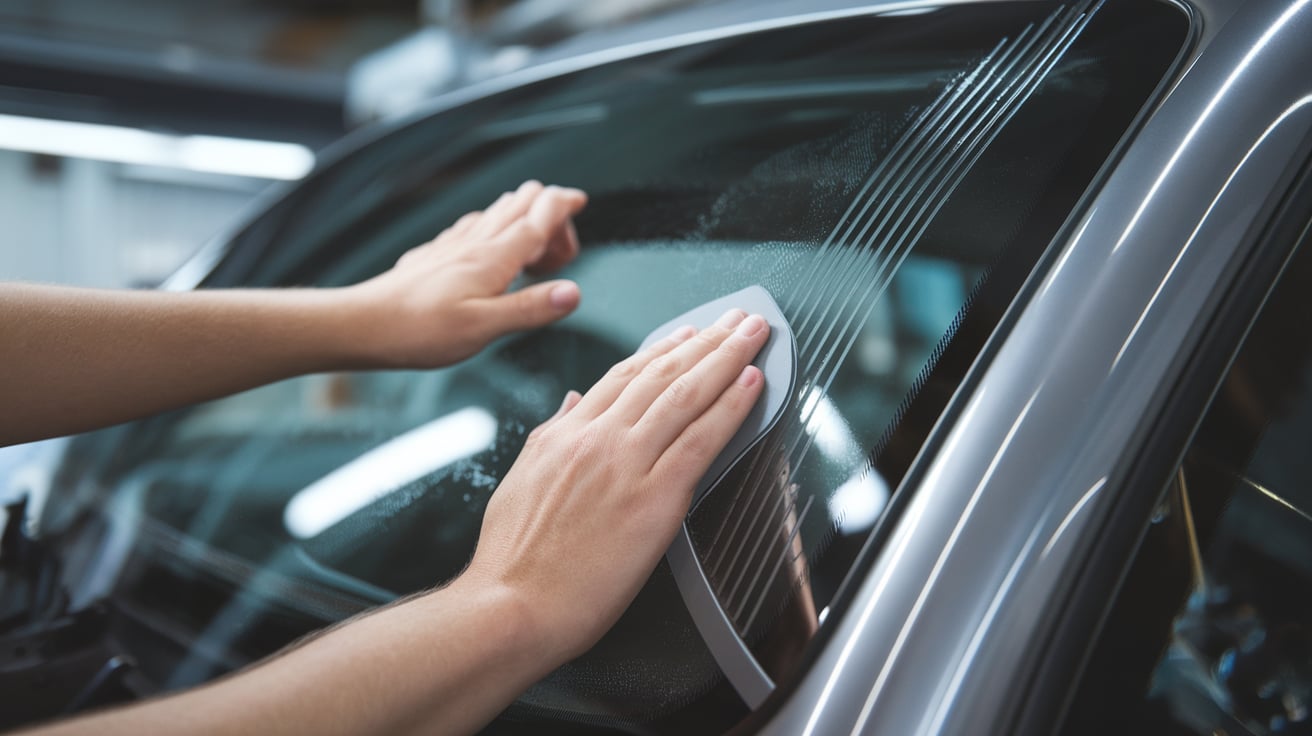
Common Slip Solution Mistakes That Damage Ceramic Film
Ceramic tint film does not give second chances. Once the adhesive reacts, it is over. And most of the time, the problem is not the film, it is the slip. Tinting Slip Solutions can go wrong in subtle ways. You do not notice during the install. You notice when the customer comes back two days later with lifting edges or streaks baked into the glass. Here are the usual suspects:
- Over-concentration: Too much soap kills tack and leaves residue
- Premature tack: Wrong ratio causes the film to grab before it is aligned
- Soap streaks: Additives in dish soap or shampoo leave visible trails
It looked perfect when I laid it. Then the heat hit, and the edges curled. Tinting Slip Solutions must be mixed for the film, not just habit. Ceramic adhesives are sensitive. They react to pH, surfactants, and even water quality. Tap water with high mineral content? That alone can cause haze. Tinting Slip Solutions are not just about glide. They are about control. And if you are guessing your mix, you are gambling with the install.
Prepping Glass for Slip Solution Application
Before you even think about mixing slip, the glass has to be clean. Not just wiped, prepped. Ceramic tint film bonds differently, and any residue, oil, or dust will mess with adhesion. Tinting Slip Solutions work best when the bonding surface is flawless. That means:
- Dot matrix cleaning: Those textured edges trap grime
- Residue removal: Old tint glue, fingerprints, even glass cleaner leftovers
- Prep solution: Use a film-safe cleaner, not ammonia-based sprays
You can’t lay premium film on a dirty canvas. Prep is half the job. In Dubai’s climate, dust settles fast. You clean, then clean again. Some techs use tack cloths. Others go with alcohol-based wipes. Whatever your method, the goal is contamination control. Slip Solutions only perform when the surface lets them. Skip the prep, and you are setting yourself up for lift lines, streaks, and comebacks.
Slip Solution Performance in Extreme Conditions (Dubai-Specific)
Dubai does not play fair. You are tinting glass that’s been sitting under the sun, easily hitting 110°F. Add humidity, and your slip mix starts evaporating before you even lay the film.
Tinting Slip Solutions behave differently in this heat. Tack accelerates. Water flashes off the glass. And suddenly, your perfect mix from last week is grabbing too fast or leaving streaks. Here is what installers adjust:
- Dilution ratios: More solution, less water to slow evaporation
- Spray timing: Mist the glass twice, once before lay, once before squeegee
- Shade control: Work under cover or cool the glass with filtered water
In Dubai, you don’t just tint. You fight the heat every step of the way. Tinting Slip Solutions must be heat-adapted. Some pros switch to SlipX or Fusion during peak hours. Others keep two bottles, one for lay, one for finish. The key is knowing how fast the glass dries and how your film reacts. Slip Solutions in Dubai are not just about chemistry. They are about survival. Get it wrong, and the film lifts before the customer even hits the road.
Choosing the Right Slip Solution for Your Tinting Workflow
There is no “best” slip solution. Only the one that fits your workflow. Some installers want slow tack for precise alignment. Others want fast bonding to speed up jobs. Either way, Tinting Slip Solutions need to match your rhythm, not fight it. Here is how pros break it down:
- SlipX vs. Tint-Tac: SlipX glides smoother, Tint-Tac grabs faster
- Shampoo vs. dish soap: Shampoo is gentler, but dish soap gives more control
- Tack timing: Adjust ratios based on film type and glass temperature
Your slip mix should feel like part of your hand, not something you wrestle with. Tinting Slip Solutions affect everything, how the film lies, how the squeegee moves, and how clean the finish looks. Some techs keep a log of what mix works best with each film. Others tweak on the fly, based on humidity and heat. Slip Solutions are not just about chemistry. They are about workflow optimization. Get the mix right, and the job flows. Get it wrong, and you are chasing creases, lift lines, and wasted time.
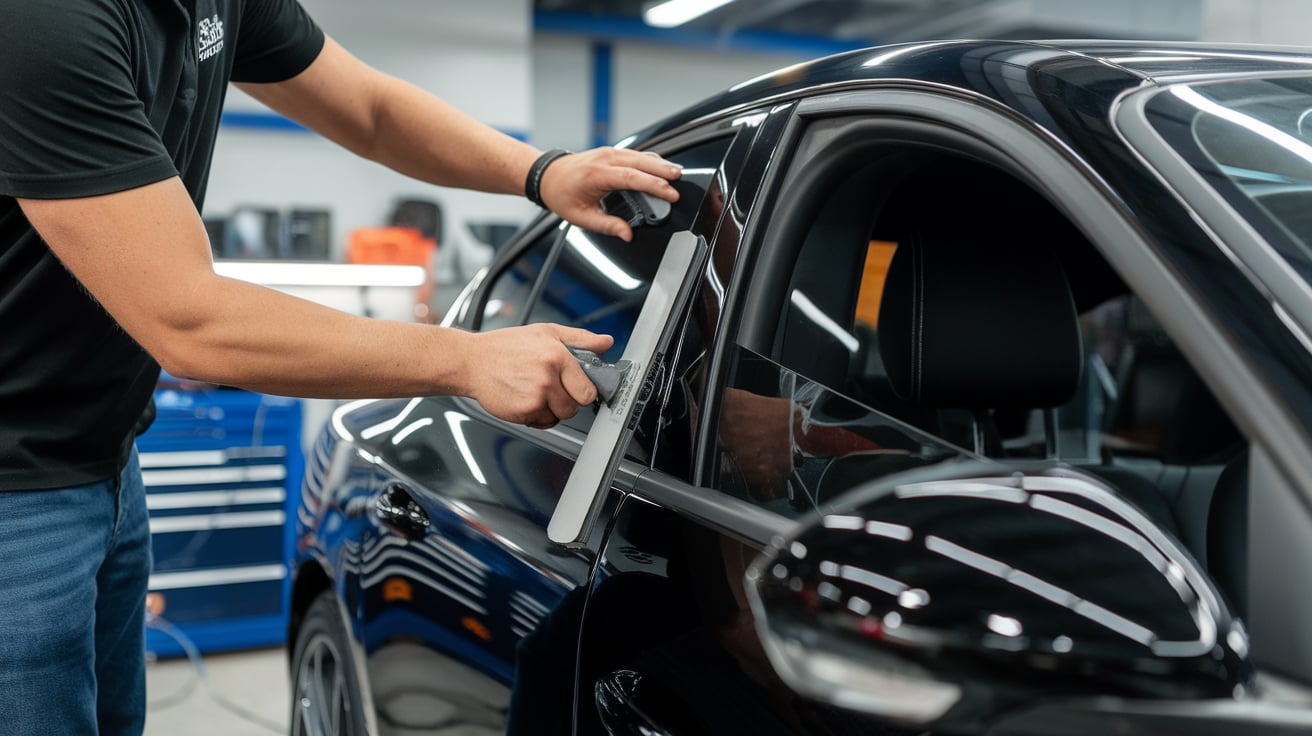
Slip Solution Compatibility Chart | Ceramic Film vs. Others
Not all films react the same. Ceramic tint? Sensitive. Dyed film? Forgiving. Metallic? Somewhere in between. That is why Tinting Slip Solutions must be tailored, not guessed. Here is how common films respond to slip mixes:
| Film Type | Adhesive Sensitivity | Slip Behavior | Notes |
| Ceramic Film | High | Needs slow tack, low residue | Avoid harsh soaps or high pH |
| Dyed Film | Low | Tolerates most mixes | Good for beginners |
| Metallic Film | Medium | Can streak with the wrong mix | Watch for signal interference |
| Hybrid Film | Medium-High | Needs balanced tack timing | Test the mix before full install |
One mix doesn’t fit all. Know your film, or risk the redo. Tinting Slip Solutions that work for ceramic may not suit metallic or hybrid films. Always test before committing. The wrong mix costs time and reputation.
Tools That Enhance Slip Solution Efficiency
Even the best mix falls flat without the right tools. In Dubai’s heat, where timing is everything, your gear needs to work as hard as you do. Tinting Slip Solutions perform better when paired with tools that control flow, pressure, and precision. Here is what pros rely on:
- Sprayers: Adjustable nozzles for misting vs. soaking
- Tack boosters: Add-ons for faster bonding when needed
- Squeegees: Soft-edge blades for ceramic film, firm for dyed
The wrong sprayer floods the glass. The right one lays the film like silk. Tinting Slip Solutions are only half the equation — the other half is how you apply and finish. Film-safe accessories, pressure control, and blade choice all affect the final result. Invest in tools that match your workflow, they don’t just save time, they save the install. It’s this attention to detail that defines our professional car tinting in Dubai, where the tools matter just as much as the film.
Service-Level Slip Solution Protocols | What We Use and Why
In a high-volume Dubai workshop, consistency is everything. You cannot afford guesswork. That is why we follow a strict service protocol for every ceramic tint install, starting with the slip. Tinting Slip Solutions are prepped daily, not reused. Each batch is mixed based on film type, weather conditions, and glass temperature. We do not eyeball ratios; we measure. Here is how our workflow runs:
- Solution prep: Measured dilution, filtered water, no tap
- Film compatibility check: Ceramic, hybrid, or dyed, each gets its mix
- Technician workflow: One tech lays, one finishes, both verify tack timing
We do not tint by feel. We tint by protocol. Tinting Slip Solutions are logged per job. If a film lifts or streaks, we trace it back to the mix. That is how we maintain quality control and client trust. Tinting Slip Solutions are not just part of the process. They are the foundation. And when the mix is right, the film lays clean, bonds tight, and stays flawless.
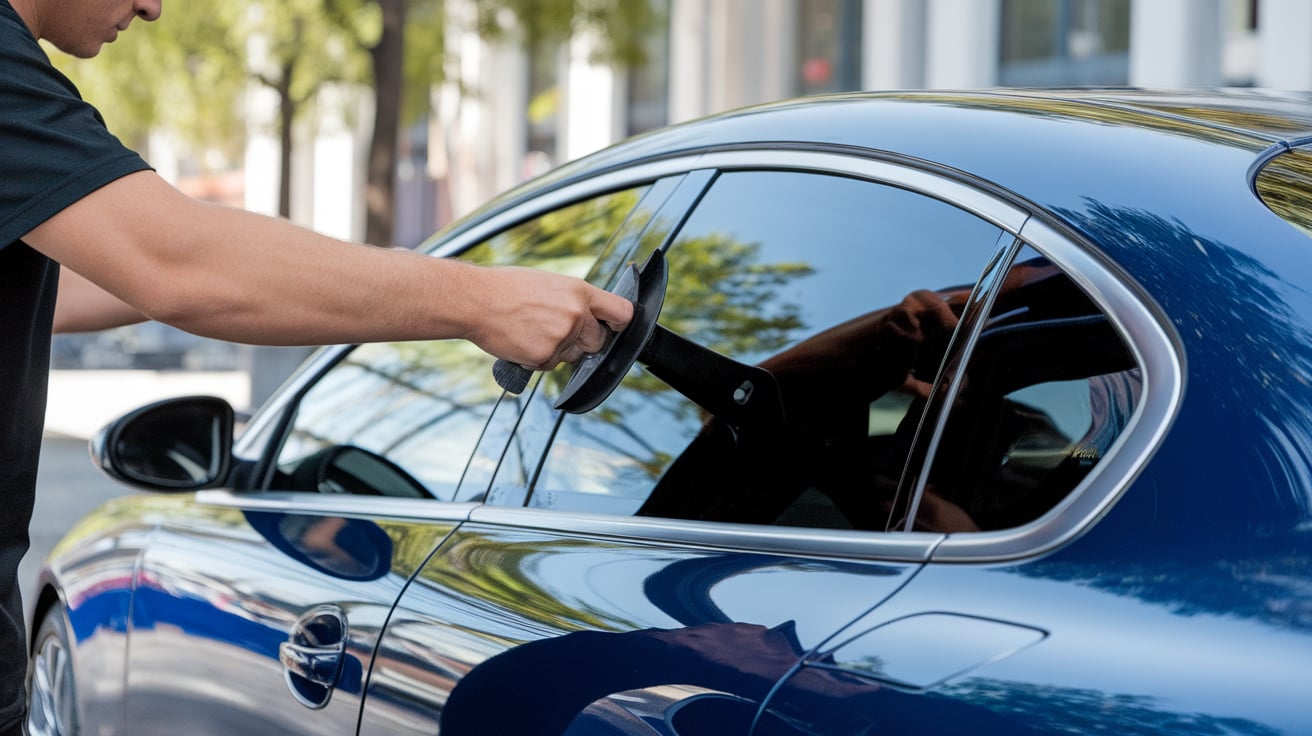
Precision Tinting with the Right Slip Solution
Ceramic film installation is not just about skill; it is about control. And that control starts with the mix. Tinting Slip Solutions are the quiet variable most installers overlook. But they decide everything: how the film is, how it bonds, and how long it lasts. In Dubai’s heat, where glass dries fast and tack accelerates, the wrong mix means comebacks.
Precision tinting is not luck. It is chemistry, timing, and knowing your tools. Tinting Slip Solutions are not optional. They are the difference between a flawless install and a film that fails before the client even gets home. When the mix is right, the film settles clean, the edges stay tight, and the job speaks for itself. Ceramic film deserves that level of care. And your reputation depends on it.

